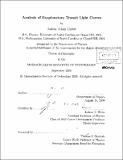Analysis of exoplanetary transit light curves
Author(s)
Carter, Joshua Adam
DownloadFull printable version (14.91Mb)
Other Contributors
Massachusetts Institute of Technology. Dept. of Physics.
Advisor
Joshua N. Winn.
Terms of use
Metadata
Show full item recordAbstract
This Thesis considers the scenario in which an extra-solar planet (exoplanet) passes in front of its star relative to our observing perspective. In this event, the light curve measured for the host star features a systematic drop in flux occurring once every orbital period as the exoplanet covers a portion of the stellar disk. This exoplanetary transit light curve provides a wealth of information about both the planet and star. In this Thesis we consider the transit light curve as a tool for characterizing the exoplanet. The Thesis can divided into two parts. In the first part, comprised of the second and third chapters, I assess what observables describing the exoplanet (and host) may be measured, how well they can be measured, and what effect systematics in the light curve can have on our estimation of these parameters. In particular, we utilize a simplified transit light curve model to produce simple, analytic estimates of parameter values and uncertainties. Later, we suggest a transit parameter estimation technique that properly treats temporally correlated stochastic noise when determining a posteriori parameter distributions. In the second part, comprised of the fourth and fifth chapters, I direct my attention to real exoplanetary transit light curves, primarily for two exoplanets: HD 149026b and HD 189733b. We analyze four transits of the ultra-dense HD 149026b, as measured by an instrument on the Hubble Space Telescope, in an effort to properly constrain the stellar and exoplanetary radius. In addition, we assess a detection of strong, wavelength dependent absorption, possibly due to an unusual atmospheric composition. For HD 189733b, we utilize seven ultra-precise Spitzer Space Telescope transit light curves in an effort to make the first empirical measurement of asphericity in an exoplanet shape. In particular, we constrain the parameters describing an oblate spheriod shape for HD 189733b and, attributing oblateness to rigid-body rotation, we place lower bounds on the rotation period of the exoplanet.
Description
Thesis (Ph. D.)--Massachusetts Institute of Technology, Dept. of Physics, 2009. Cataloged from PDF version of thesis. Includes bibliographical references.
Date issued
2009Department
Massachusetts Institute of Technology. Department of PhysicsPublisher
Massachusetts Institute of Technology
Keywords
Physics.